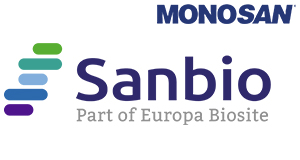Mouse anti-SMAD4 (DPC4), clone B-8 (Monoclonal)
Mouse anti-SMAD4 (DPC4), clone B-8 (Monoclonal)
Artikelnummer
SANMON10228
Verpackungseinheit
1 ml
Hersteller
Sanbio / Monosan
Verfügbarkeit:
wird geladen...
Preis wird geladen...
Clone Number: B-8
Immunogen: Amino acid 1-552 representing full length Smad4 of human origin
Concentration: n/a
Format: Purified
Storage buffer: Purified antibody fraction from mouse anti-serum with 0.2% BSA and 15mM sodium azide
Additional info: Signaling from the ligand-activated membrane receptor serine/threonine kinases to nuclear targets is mediated by a set of evolutionarily conserved proteins known as SMADs. Upon ligand binding, the receptors of the TGF-β family phosphorylate SMAD proteins (SMAD1 and SMAD2). These proteins then move into the nucleus, where they activate transcription. To carry out this function, the receptor activated SMAD 1 and 2 require association with the product of deleted in pancreatic carcinoma, locus 4 (DPC4), also known as SMAD4. SMAD4/DPC4 is also implicated as a tumor suppressor, since it is inactivated in more than half of pancreatic carcinomas and to a lesser extent in a variety of other cancers. The lack of SMAD4 expression is present in approximately 80% of cases of pancreatic adenocarcinoma, but rarely in endometrial (0%), colorectal (0%), ovarian (3%), lung (0%), breast (2%) adenocarcinomas, and malignant melanoma (4%). SMAD4 is an important marker for confirming a diagnosis of pancreatic adenocarcinoma. Patients with pancreatic adenocarcinomas with SMAD4 protein expression had significantly longer survival than SMAD4 negative patients. Pretreatment: Heat induced epitope retrieval in 10 mM citrate buffer, pH6.0, or in 50 mM Tris buffer pH9.5, for 20 minutes is required for IHC staining on formalin-fixed, paraffin embedded tissue sections. Note: Dilution of the antibody in 10% normal goat serum followed by a goat anti-mouse secondary antibody-based detection is recommended. Control tissue Pacreatic adenocarcinoma. Staining Nuclear.
Immunogen: Amino acid 1-552 representing full length Smad4 of human origin
Concentration: n/a
Format: Purified
Storage buffer: Purified antibody fraction from mouse anti-serum with 0.2% BSA and 15mM sodium azide
Additional info: Signaling from the ligand-activated membrane receptor serine/threonine kinases to nuclear targets is mediated by a set of evolutionarily conserved proteins known as SMADs. Upon ligand binding, the receptors of the TGF-β family phosphorylate SMAD proteins (SMAD1 and SMAD2). These proteins then move into the nucleus, where they activate transcription. To carry out this function, the receptor activated SMAD 1 and 2 require association with the product of deleted in pancreatic carcinoma, locus 4 (DPC4), also known as SMAD4. SMAD4/DPC4 is also implicated as a tumor suppressor, since it is inactivated in more than half of pancreatic carcinomas and to a lesser extent in a variety of other cancers. The lack of SMAD4 expression is present in approximately 80% of cases of pancreatic adenocarcinoma, but rarely in endometrial (0%), colorectal (0%), ovarian (3%), lung (0%), breast (2%) adenocarcinomas, and malignant melanoma (4%). SMAD4 is an important marker for confirming a diagnosis of pancreatic adenocarcinoma. Patients with pancreatic adenocarcinomas with SMAD4 protein expression had significantly longer survival than SMAD4 negative patients. Pretreatment: Heat induced epitope retrieval in 10 mM citrate buffer, pH6.0, or in 50 mM Tris buffer pH9.5, for 20 minutes is required for IHC staining on formalin-fixed, paraffin embedded tissue sections. Note: Dilution of the antibody in 10% normal goat serum followed by a goat anti-mouse secondary antibody-based detection is recommended. Control tissue Pacreatic adenocarcinoma. Staining Nuclear.
| Artikelnummer | SANMON10228 |
|---|---|
| Hersteller | Sanbio / Monosan |
| Hersteller Artikelnummer | MON10228 |
| Verpackungseinheit | 1 ml |
| Mengeneinheit | STK |
| Reaktivität | Human |
| Klonalität | Monoclonal |
| Methode | Immunohistochemistry (paraffin) |
| Isotyp | IgG1 |
| Wirt | Mouse |
| Konjugat | Unconjugated |
| Produktinformation (PDF) | Download |
| MSDS (PDF) |
|

 English
English







